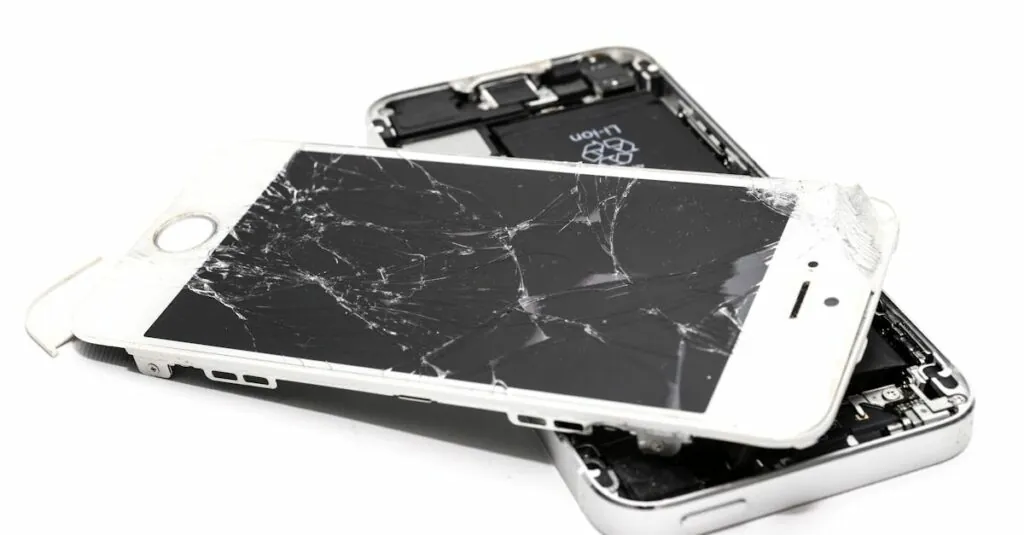Table of Contents
TogglePicture this: you’re all set to capture that perfect sunset selfie, but your iPhone decides to throw a tantrum, flashing the dreaded “iPhone unavailable” message. Frustrating, right? It’s like your phone has suddenly developed a personality and is refusing to cooperate. But don’t worry; you’re not alone in this tech drama!
Understanding the Issue
iPhone users often find themselves frustrated when facing the “iPhone unavailable” message. Identifying the underlying causes and recognizing the symptoms can lead to quicker solutions.
Common Causes of Unavailability
This message frequently results from forgotten passcodes, too many incorrect attempts to unlock the device, or issues with the software. Various hardware failures may also contribute to the problem. Compatibility issues can arise after an iOS update, causing temporary glitches. Sometimes, users neglect network connectivity, which impacts device functionality.
Symptoms of an Unavailable iPhone
An unavailable iPhone often displays specific indicators. Users may notice a black screen that persists, a message indicating unavailability, or an inability to access apps. Some experience failure to connect to Wi-Fi or cellular networks. Unexpected restarts or slow performance can occur too. Recognizing these symptoms helps in taking appropriate action.
Step-by-Step Solutions
Several methods can fix the “iPhone unavailable” message. Users can follow these techniques for potential resolutions.
Restarting Your iPhone
Restarting an iPhone often resolves minor issues. Press and hold the side button and either volume button until the slider appears. After releasing the buttons, drag the slider to turn off the device. Wait for about 30 seconds before pressing the side button again until the Apple logo appears. This simple step refreshes the device’s memory and can eliminate temporary software glitches.
Using Recovery Mode
Attempting to use Recovery Mode can help when the iPhone remains unavailable. Connect the iPhone to a computer using a USB cable, then open iTunes or Finder. Next, press and hold the correct button combination for your iPhone model until the Recovery Mode screen appears. Follow the on-screen instructions to either update or restore the device. This method works effectively in cases of serious software issues.
Updating or Restoring via iTunes
Updating or restoring via iTunes provides options for resolving deeper system-level problems. Connect the iPhone to the computer using a USB cable. Open iTunes or Finder, then select the device from the sidebar. Choose “Check for Update” first to see if a software update is available. If that doesn’t help, select “Restore” to erase the device and reinstall the operating system. Ensure data backs up beforehand as this process deletes all content.
Additional Troubleshooting Tips
Further steps can enhance the chances of resolving the “iPhone unavailable” issue. Below are some additional troubleshooting strategies.
Checking for Software Updates
Ensuring the iPhone runs the latest software minimizes glitches. Open the Settings app, navigate to General, and select Software Update. If an update is available, downloading and installing it often resolves various problems. Regular updates not only improve functionality but also enhance security features on the device. Checking for updates regularly helps keep the iPhone performing optimally.
Resetting Network Settings
Resetting network settings can rectify connectivity issues contributing to the “iPhone unavailable” message. Access the Settings app, choose General, and then tap on Transfer or Reset iPhone. Selecting Reset followed by Reset Network Settings prompts a confirmation. This process eliminates saved Wi-Fi networks and passwords, returning them to default settings. After this reset, reconnecting to networks may resolve underlying connectivity problems. Making this adjustment can significantly enhance device performance.
Prevention Tips
Preventing the “iPhone unavailable” message can save users time and frustration. Implementing simple strategies keeps devices running smoothly.
Regular Backups
Regular backups protect valuable data and settings. Backing up the iPhone via iCloud or iTunes ensures access to important files during unforeseen issues. Users should set automatic backups to minimize the risk of data loss. By regularly syncing, devices remain secure and users avoid lengthy recovery processes. Frequent backups also simplify restoring settings if problems arise.
Keeping Your iPhone Updated
Keeping the iPhone updated enhances overall functionality and security. Apple releases updates to address bugs and improve performance. Users should enable automatic updates to ensure the device always runs the latest software. Checking for updates manually can also be beneficial in identifying potential fixes for existing issues. Staying current with iOS updates effectively minimizes the risk of encountering the “iPhone unavailable” message.
Dealing with the “iPhone unavailable” message can be frustrating but understanding the issue is the first step toward resolution. By following the outlined solutions and troubleshooting tips, users can effectively restore their devices to full functionality. Regular backups and software updates are essential practices that not only safeguard data but also enhance overall performance. Staying proactive can help prevent future occurrences of this annoying message, allowing users to enjoy their iPhones without interruption. With the right approach, overcoming this technical hurdle is achievable.





